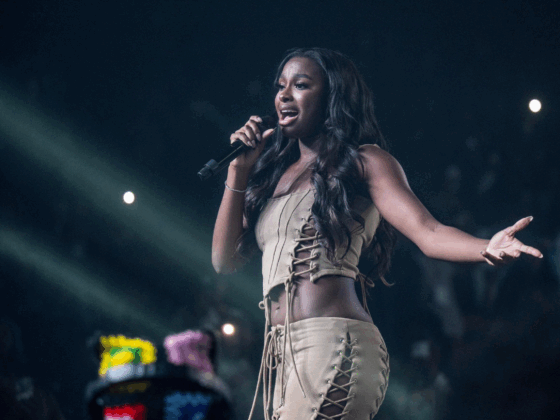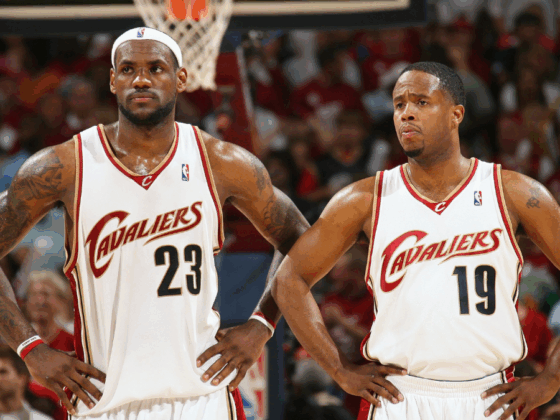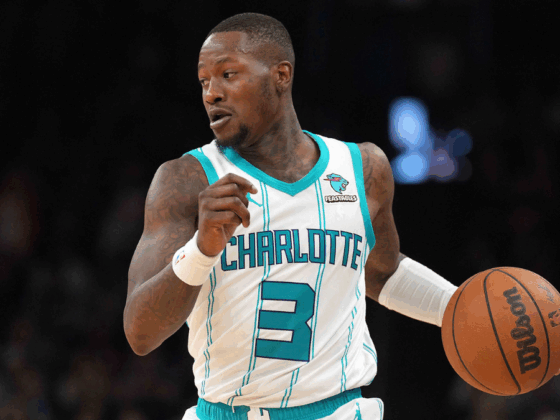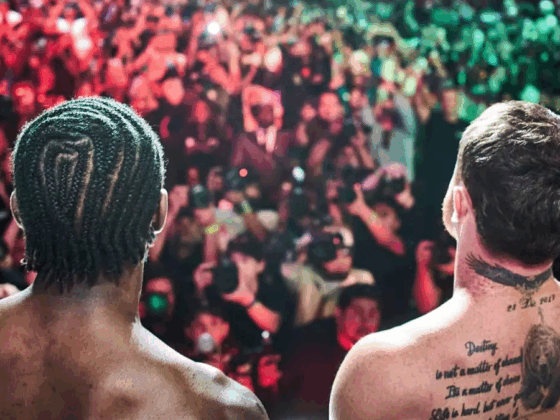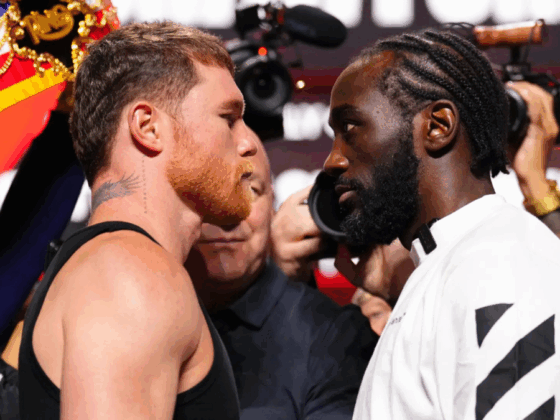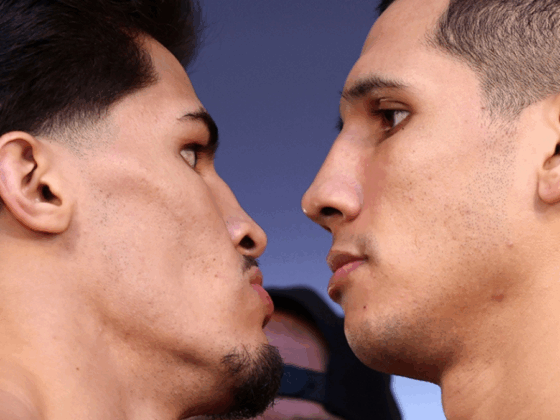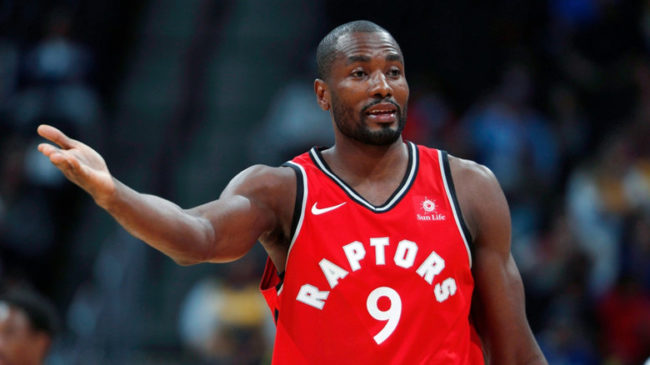
When Masai Ujiri traded for Serge Ibaka, it was seen (rightfully at the time) as an absolute steal. The Raptors were all in on their core, and adding a player like Ibaka who had routinely been a solid third option on good Thunder teams made a great deal of sense. His shot-blocking ability and his improved shooting stroke were acquired for a mere fee of Terrence Ross and a late first-round pick. The Raptors also got access to his bird rights in the trade, which meant that they had an advantage at re-signing him in the 2017 off-season.
Just 15 months on from that masterstroke of a trade, Serge Ibaka’s play has declined to the point that Raptors bloggers are expecting him to be moved this summer. Masai Ujiri could sell ice to an Eskimo, so a trade for Ibaka could quite easily happen. At this point though, it is hard to see what value Ibaka has for any team trying to seriously contend. And his decline in impact is something that needs to be discussed when analyzing the Raptors getting swept in the second-round.
A lot of things went wrong for Toronto in this post-season and it is important to be responsible and not blame it on one man, but the decline of Serge Ibaka has been one of the biggest problems for the Raptors. Ibaka was brought in so the Raptors could stay big and still keep the floor spaced out, and while he has shot well from beyond at 37 percent in the playoffs, his lack of mobility has limited the number of opportunities he has had from downtown.
When the Raptors got Ibaka in 2017, they were essentially getting the best of multiple worlds. Ibaka has the floor spacing ability to play in the traditional four position, but he also had the ability to play as a rim-protecting center in small-ball lineups. His ability to play as the traditional four fits well with the Raptors roster because they have an offensive dynamo in the form of big man Jonas Valanciunas. The Lithuanian, in combination with Jakob Poeltl, helps form the deepest center depth chart in the NBA.
Before taking a look at Serge Ibaka’s defensive problems in the playoffs, it makes sense to note one thing- the Raptors were an offensive juggernaut with him on the court in the playoffs. Although at times it did look like he was struggling, Ibaka’s floor spacing created extra driving angles and gave the Raptors an offensive rating of 117 when he was on the court. This number dropped to 107 when he was off the court. Many think Ibaka was a disaster on both ends, but he created gravity on the offensive side of the ball which is essential for any team. However, he is supposed to be on the team for his defense, but on that end, he was completely unusable in this series.
At the beginning of game two in the second-round, the Cavaliers opened with a small lineup and Toronto responded by putting Serge Ibaka on JR Smith. It is clear why Dwane Casey opted to do this, as Jonas Valanciunas on a guard would have been a recipe for disaster. But if you are using a defensive specialist like Ibaka, you expect them to be utilized as a rim protector more often. This raises questions about whether Ibaka and Valanciunas can really fit together in a small ball dominated NBA, because the Lithuanian can really only defend bigs, and Ibaka has become so immobile that Dwane Casey was legitimately hiding him on defense at times even though he is better as a rim protector. When you consider that the Raptors signed him to be a defensive phenom, this is very worrying.
Not only was Ibaka a terrible fit with Valanciunas defensively, but he was a terrible fit as the stretch center on offense. Lineup flexibility was seen as the major pro when they signed Ibaka, but this idea did not really become reality, as the Raptors were woeful with him at the five. The most used lineup throughout the playoffs with Ibaka at the five and Anunoby posted a net rating of -30. Ibaka simply struggled to play alongside a small ball-four, and this has to be worrying because the idea of this move was that Ibaka would create an offensive pairing with Jonas Valanciunas, and then allow the Raptors to run an effective small ball lineup when Valanciunas went to the bench.
There are two main reasons for Ibaka’s defensive struggles in the playoffs. The first, more obvious reason, is that Ibaka is getting old. Ibaka is only 28, but he has been playing basketball at a high level for 11 years, and that kind of workload is obviously going to wear a guy down. Especially one as intense as Ibaka. Ibaka has played in many deep-postseason runs, and he did seem a little tired, which is the reason his offensive game looked so chaotic at times. The other reason he struggled is that the defensive role of an NBA big man has changed, and it is unclear whether Ibaka has changed with it.
Ibaka is a brilliant shot blocker who was at his best when he was asked to defend against people his own size when he was near the basket. But in this NBA, big men need to be able to move out and play in space, and there are very few defenders who look as lost out in space as Serge Ibaka does. Ibaka is having similar problems to Hassan Whiteside, who has also been exposed as a defender in space, so it is no surprise that both guys are going to find themselves on the trade block.
The play below was one that was too common for the Raptors in the series against Cleveland. Serge Ibaka was pulled out into space in order to switch onto Kevin Love. Ibaka looks completely lost in space on the possession and George Hill blows by him for an easy layup. Sure, Ibaka does have to worry about Love shooting from beyond, but he has to be better in order to get across and stop George Hill:
The clip below is another example of Ibaka’s defensive limitations. Dwane Casey started game four with Ibaka as the small ball center, and the results weren’t great early on. The Raptors help defense was meme-d to death throughout the series, but on this play the help forces George Hill to retreat out and pass it back to Kevin Love. For a small ball NBA defense in 2018, this should be the best case scenario, the driving angle was cut off and a big man receives the ball in an isolation situation on the perimeter. Unfortunately for Toronto, Ibaka completely overcommits and ends up falling over. This play really should have resulted in a contested three or a fadeaway post-up, but because Ibaka cannot hang out in space at all, Cleveland ended up with a lay-up:
The next defensive play for Ibaka was somehow even worse, just in a different way. Ibaka is with Love at the beginning of the play, but he completely switches off and Love finds himself with an open jump shot. A shot doesn’t go up, but the Cavs find success later:
Some small ball fives, such as Draymond Green and Bam Adebayo, will often take up a position like this in order to stop a cross-court pass, but the issue with Ibaka playing this role is that he does not have the lateral quickness to quickly get out to the perimeter. In a sense, Ibaka looks two or three seconds behind on this play. The result is that the Raptors defense has to collapse on a set where Cleveland once again should have ended up with the ball stuck on the perimeter. This instead ends up with an open three for Kyle Korver, which never ends well.
Dwane Casey obviously saw Ibaka’s defensive struggles at the four and opted to put him as the full time five in game four on Monday night. But this just exposed his lateral quickness or lack thereof. In many ways, Ibaka has likely played himself out of Toronto, as he was a black hole on the offensive end and his lack of lateral quickness was exposed by small ball lineups. It is for this reason that finding a trade partner could be difficult, anyone who watched the playoffs will have seen his limitations. However, if anyone can manage to sell him, it’s Masai Ujiri.
